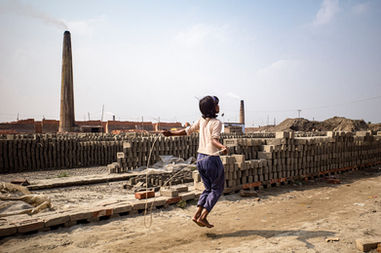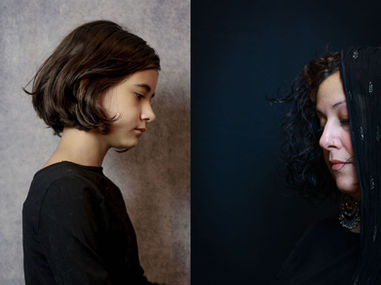
PICTORIAL STORY
June 12, 2020
DEBUTANTE
Photography by Jo Kalinowski
Story by Karin Svadlenak Gomez
Jo Kalinowski is an Australian photographer, whose work is inspired by a connection between her British urban roots and her current life in rural Victoria. Over the past few years Jo has been exploring man-made and natural landscapes through minimalist style fine art photography, and more recently Jo has been working on social documentary photography projects. She has a knack for candidly capturing events and people in a documentary, but with her very personal style. I discovered Jo's beautifully tender photo reportage series about a Debutante Ball, and I interviewed her to find out more about the way this tradition is celebrated in Australia.
-min.jpg)
Jo Kalinowski never thought of attending a Debutante ball, it just was not her thing. But when her daughter Alex ran into the house, telling her excitedly “Mum I have found a partner for the Debutante! What if I never get married? It may be my only white dress opportunity!", a new photographic project idea was born. Jo decided to explore the Debutante journey by documenting her daughter's experience photographically. She wanted to capture and create images that Alex could keep for a lifetime: photographs that were elegant, flattering, and that celebrated her night. At the time, Jo was relatively new to documentary photography and did not have a specific plan how to go about it. “I chose to improvise, trusting my intuition that the images I shoot will connect to each other. But it was not until sometime later, looking back at the work, that I became inspired and was able to see that I captured a story I am compelled to share,” she says.
THE ORIGINS OF "COMING OUT"
The tradition of Debutante balls originated with the way aristocratic or upper-class families have historically 'presented' young women (the 'debutante' - from French, literally the 'novice') to polite society, once they had reached 'maturity' for entering the marriage market at a formal 'debut' or a Debutante ball. This type of formal 'coming out' was a way of putting the young women on display for eligible bachelors in hopes of finding a suitable match for them within a select circle.
In the United Kingdom girls from aristocratic or upper-class families used to be 'launched into society' at the age of 17 or 18 through a formal introduction to the monarch, making their debut at a royal ball, wearing strictly prescribed white gowns with gloves and veils, like brides. Queen Elizabeth II finally terminated the formal court presentations of debutantes in 1957.
AN OLD TRADITION IN MODERN TIMES
One would think that such an old-fashioned tradition as the Debutante ball has long been relegated to the annals of history, but it is actually still going strong, though in a modified format and with not quite the same meaning attached. After all, no reasonable parent would want to marry off their daughter at the age of 17 these days. In the United Kingdom, although the formal social season ended eventually, today there are still 'socialite' events being held in the early spring and summer. An extensive ball season is also on every winter in my home city, Vienna, and although it has nothing to do with 'introducing' girls to society, many young women enjoy the experience of opening a ball in a white gown, dancing a set of choreographed figures with their white-gloved partners for an audience of eager spectators. A variation on the tradition also exists in several Latin American countries. Young girls (quinceañeras) take part in a Festival de Debutantes, or a "Quince Años" party upon their fifteenth birthday.
Although societies have become more egalitarian, making such events more accessible, they can also still be quite elitist. In the United States, for example, an International Debutante Ball takes place every year, attended by girls from various countries, among them the daughters of presidents and of other wealthy families. The ball is considered the ultimate networking event, where the rich and powerful mingle.
A more accessible version of the Debutante ball may be the high school prom (short for promenade), which really is more about dating and dancing than about an introduction to society. “I don’t think the girls look like brides at the American Style Prom! I think the two have a different meaning attached to them. The prom is more an end of year formal dance for high school students and seems much more casual,” Jo explains. Still, teenage girls attending a prom might end up becoming the 'queen' of the ball for a night.
Australia, where Jo made her documentary, is better known for informal BBQ than for formal society events, but I was surprised to learn that it also still has Debutante balls, usually organized by high schools, church groups or service clubs, such as Lions or Rotary, for girls aged between 15 and 18. Like in the other countries where the tradition exists, the debs' floor length ball gowns are kept in virginal white, making the girls look like brides - although marriage is probably furthest from their mind that night.
Jo's photographs offer the viewer an intimate look into a tradition that they may not have come into contact with before. She intends her images to trigger an emotion or feeling that the viewer can relate to, and engage with. “Adolescence is a time when emotions run high and are felt so strongly, and I would hope that viewers can catch glimpses of that in this series.” Jo aims to create scenes around the concept she is investigating. Her images of the ball convey a special intimacy and often focus on details, because she feels a need to express ideas with a creative approach to getting at something deeper than our common notions of family photographs. “I like to shoot close, It gives me a deeper connection to what I want to capture, that sense of intimacy.”
PREPARING FOR THE BIG DAY
You may have seen Baz Luhrmann’s Australian 1992 movie classic Strictly Ballroom, which features a small ballroom dance school participating in dance competitions. (If you are not familiar with the film, I can recommend it.) Nevertheless, ballroom dancing is not a huge part of Australian culture. Rather it is a niche discipline, and it is only on certain occasions, for example for a Debutante ball, that most teenagers make the effort to learn ballroom dances.
Preparations for the ball are taken almost as seriously as planning a wedding would be. To prepare for the ball, the debutantes line up their partners months in advance, and together they spend 12 weeks preparing for the ball. Dances are learned at the school. The Tango, Gypsy Tap, Cha Cha, Progressive Jive are just a few from the list of dances. “And let’s not forget the all important and numerous dress fittings,” Jo adds.
The girls get to pick their own partner. Jo's daughter Alex successfully recruited the boy next door for it. The Debutante ball is less common these days, more often held in smaller country towns. Although it was created as a formal introduction for young women into society and may not retain the prestige of yesteryear, the debutantes are very invested in their role.
MIXED FEELINGS
Jo has mixed feelings about this type of event. “I have created images that celebrate this ball mainly because I was framing it through my daughter's desire to be part of this ongoing tradition. But I also recognise that there are complicated issues that can lie beneath the surface of an image or a series,” says Jo. For her there are concerns regarding privilege and exclusivity, as the Debutante is a very expensive exercise and not every teenage girl has the financial background to enable her to be part of it. “Also, I would imagine in the school social sphere that there are those girls who perhaps don’t even have the option of finding a suitable partner.”
When she photographed the event, Jo felt as if she were observing a theatrical performance from behind the camera. “The event was fun, a real ball! Proud families and happy teenagers all playing their part in this mad charade.”

On further reflection it has really made Jo consider how we frame experiences. In this instance, although there was so much she does not agree with regarding the tradition and the traditional roles the debutante concept assigns to young girls in Australian culture, Jo feels that her coverage of the event should be interpreted as a positive look at the joys of youth and the celebration that her daughter will hopefully remember fondly.
“Because at the end of the night, it was her night.”

The views, thoughts, and opinions expressed in the text belong solely to the author/s, and are not necessarily shared by The Pictorial List and the team.



































